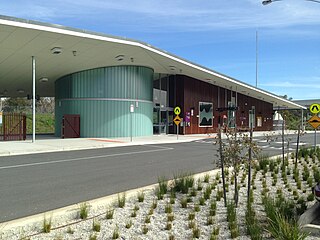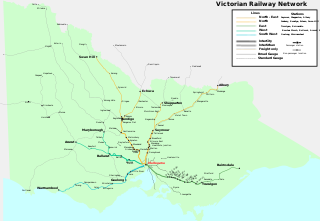
Tallangatta is a town in north-eastern Victoria, Australia. The town lies on the banks of the Mitta Arm of Lake Hume, approximately 38 kilometres (24 mi) south-east of Albury-Wodonga along the Murray Valley Highway. At the 2021 census, Tallangatta had a population of 1,175.

Albury is a major regional city that is located in the Murray region of New South Wales, Australia. It is located on the Hume Highway and the northern side of the Murray River. Albury is the seat of local government for the council area which also bears the city's name – the City of Albury. It is on the Victoria–New South Wales border.

Hume Dam, formerly the Hume Weir, is a major dam across the Murray River downstream of its junction with the Mitta River in the Riverina region of New South Wales, Australia. The dam's purpose includes flood mitigation, hydro-power, irrigation, water supply and conservation. The impounded reservoir is called Lake Hume, formerly the Hume Reservoir. It is a gated concrete gravity dam with four earth embankments and twenty-nine vertical undershot gated concrete overflow spillways.

Wodonga railway station is located on the North East line in Victoria, Australia. It serves the city of Wodonga, and it opened on 25 June 2011.

Rail transport in the Australian state of Victoria is provided by a number of railway operators who operate over the government-owned railway lines. The network consists of 2,357 km of Victorian broad gauge lines, and 1,912 km of standard gauge freight and interstate lines; the latter increasing with gauge conversion of the former. Historically, a few experimental 762 mm gauge lines were built, along with various private logging, mining and industrial railways. The rail network radiates from the state capital, Melbourne, with main interstate links to Sydney and to Adelaide, as well as major lines running to regional centres, upgraded as part of the Regional Fast Rail project.
Australians generally assumed in the 1850s that railways would be built by the private sector. Private companies built railways in the then colonies of Victoria, opened in 1854, and New South Wales, where the company was taken over by the government before completion in 1855, due to bankruptcy. South Australia's railways were government owned from the beginning, including a horse-drawn line opened in 1854 and a steam-powered line opened in 1856. In Victoria, the private railways were soon found not to be financially viable, and existing rail networks and their expansion were taken over by the colony. Government ownership also enabled railways to be built to promote development, even if not apparently viable in strictly financial terms. The railway systems spread from the colonial capitals, except for a few lines that hauled commodities to a rural port.
The South Gippsland railway line is a partially closed railway line in Victoria, Australia. It was first opened in 1892, branching from the Orbost line at Dandenong, and extending to Port Albert. Much of it remained open until December 1994. Today, only the section between Dandenong and Cranbourne remains open for use. The section of the line from Nyora to Leongatha was used by the South Gippsland Tourist Railway until it ceased operations in 2016. The section from Nyora to Welshpool, with extension trail to Port Welshpool and a portion of the former line at Koo Wee Rup, have been converted into the Great Southern Rail Trail.
The North East railway line is a railway line in Victoria, Australia. The line runs from Southern Cross railway station on the western edge of the Melbourne central business district to Albury railway station in the border settlement of Albury-Wodonga, serving the cities of Wangaratta and Seymour, and smaller towns in northeastern Victoria.

The former Victorian Railways, the state railway authority in Victoria, Australia, built a number of experimental 2 ft 6 in narrow-gauge lines around the beginning of the 20th century. Although all were closed by the early 1960s, parts of two have been reopened as heritage railways.

The N Class are a class of diesel locomotives built by Clyde Engineering in Somerton for V/Line between 1985 and 1987.

The Powelltown tramway was a 3 ft narrow gauge tramway that operated between Powelltown and Yarra Junction, Victoria, Australia, between 1913 and 1945.

The Robinvale railway line is a freight only country railway line in north-western Victoria, Australia. The line branches from the Mildura line at Dunolly, and at Inglewood the Eaglehawk – Inglewood line connects with the Piangil line outside Bendigo. The parallel Kulwin line junctions from the Robinvale line at Korong Vale then continues northward.
The Sydney–Melbourne rail corridor is approximately 953-kilometre (592-mile) standard-gauge railway corridor that runs between Sydney and Melbourne (Victoria), the two largest cities in Australia. Freight and passenger services operate along the route, including the NSW TrainLink XPT passenger service.

The High Country Rail Trail is a 35 kilometre, part-gravel part-sealed rail trail on the northern border of Victoria, Australia. It runs along the former Cudgewa railway line from Wodonga, along the edge of Lake Hume, to Shelley railway station in the former township of Shelley, Victoria. The eight kilometre section east from Tallangatta to Old Tallangatta is sealed; the remainining sections are not sealed but are accessible on hybrid, gravel, or mountain bikes.
The Mansfield railway line is a closed 121-kilometre (75 mi) branch railway line situated in the Hume region of Victoria, Australia. Constructed by the Victorian Railways, it branched from the Seymour line at Tallarook station, and ran east to Mansfield. The line was primarily built to provide a general goods and passenger service to settlements in the area.
Huon is a closed station located in the town of Huon, on the Cudgewa railway line in Victoria, Australia. Huon Railway Station, had officially opened in 1889 being known as "Huon Lane" until 1904. Huon was erected as part of the "octopus act", an infamous railway building act consisting of 65 proposed railway projects in Victoria. The Cudgewa Line branched off at the former Wodonga Station, creating a junction station for passengers wishing to travel on the Cudgewa line.
Ebden is a closed railway station, located in the town of Ebden, on the Cudgewa line in Victoria, Australia. All buildings were removed after the closure of the line, leaving only the platform mound remaining.
The Noojee railway line is a closed railway line in Victoria, Australia. Branching off from the Gippsland line at Warragul station, it was built to service the timber industry in the upper Latrobe River area, transporting timber as well as providing a general goods and passenger service to townships in the area. The final section of the line between Neerim South and Noojee traversed increasingly hilly terrain and featured a number of large timber trestle bridges. Extensively and repeatedly damaged by bushfires over the years, the line was closed in the 1950s and dismantled. The last remaining large trestle bridge on the line has been preserved and has become a popular local tourist attraction.

Bonegilla is a bounded rural locality of the City of Wodonga local government area in north-east Victoria, Australia, ten km (6 mi) east of Wodonga, and around 300 km (190 mi) north-east of Melbourne. At the 2021 census, Bonegilla and the surrounding area had a population of 610.











